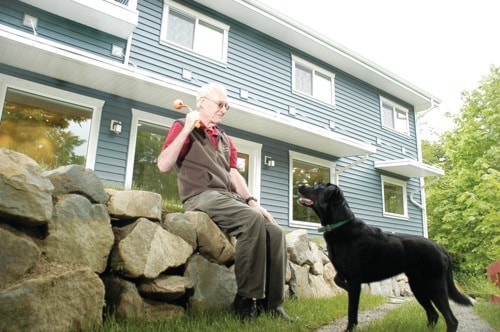Mike Legge owns the house of the future.
It will adjust itself to ensure airflow is even throughout the 2,200-square-foot floor plan. It will alter the flow of warm water to ensure the heated floor is completely homogenous for temperature. Its passive solar design will keep the hot summer sun out and take in the more welcome winter rays.
The living space – that is, floor level to six feet or so where human beings travel – will be immaculately comfortable with no fluctuations in humidity or temperature.
The house will record the outside weather and advise the 36 built-in sensors inside how to compensate.
Through an iDus Controls water system, grey water from the shower, bath, laundry and kitchen are directed to the toilets before being flushed away, saving at least 40 per cent in water use, while the rest of the house will see an annual energy savings of at least 80 per cent.
Incredibly, it’s all run through two Google Androids, allowing Legge more time to cultivate his beautiful and lush property situated by the Millstone River, or throw a ball for his dog Chester.
“It’s exactly what I envisioned when we drew up the plans,” said Legge, who approached B. Gallant Homes more than 18 months ago to build a house that met BuiltGreen platinum standards.
His home rates an 83 on the EnergyGuide scale, one of the most efficient homes anywhere, and was built in a leisurely 12 months.
“It’s an investment. My thinking was, if we have the ability to do this and it isn’t that much more expensive, if at all, then why wouldn’t we do it and save money in the long run,” said Legge, a retired physician.
Despite the high-tech systems, the build cost was only slightly more on average per square foot than a normal build, coming in at around $171 per square foot ($154 per square foot not including the basement, which won’t be finished). An average build per square foot is about $130 to $140, according to Steve Strenja of B. Gallant Homes.
“We build all of our homes to a gold standard minimum,” said Strenja. “And we have built three other homes to a platinum standard. To reach 83 points on this house we focused on water, energy use and indoor air quality and we learned a few things on this project that we now have a template for.”
Part of the learning process was to use Structural Insulated Panels for the walls instead of Insulated Concrete Forms, which the building team found worked better for below grade walls.
SIP technology, which was used in the roof for Legge’s house, offers plenty of benefits over traditional stick-framed and batt insulation construction, including time savings (about 50 per cent faster), superior energy efficiency and a tighter envelope with a stronger build result.
Mat Hallam-Eames of Qmata Technologies Inc.,which installed the house’s energy systems, said the SIP panels and energy systems all work together to maximize the structure’s efficiency.
“From the construction to the interior systems and the passive solar features, they all work together to make the house as energy efficient as possible while making the habitable space as comfortable as possible. This house is the future of home building,” said Hallam-Eames.
Darrin Boyko of SIPerior Panelworks echoed that statement, saying that as soon as next year, building codes will start making strides toward requiring smarter, stronger and more efficient builds.
“It’s hard for people to wrap their heads around it right now because to make a house more efficient, a homeowner has to pay $10,000 or whatever the amount to add a feature that will improve efficiency. But the payback only comes back in small amounts over a long period of time so it’s not attractive,” he said. “What this house is doing is integrating all of these features into the build right from the start at a reasonable price and the repayment comes in the form of significantly reduced energy bills.”
Boyko added that for most people owning a home, they look at the most significant cost – the mortgage. With energy prices set to soar, how efficient a home is will soon dictate if it’s affordable as much mortgage rates, which are relatively stable.
For Legge, he takes comfort knowing that his dream home will use less energy, leaving more in the future for his four children and five grandchildren, and that the systems he has installed will actually pay him back over time instead of stealing money from his wallet.
“The proof is in the pudding,” he said. “We’ll know just how efficient it is once I’ve been here a year or so.”
Legge plans to move in mid-June, but has agreed to allow the public to take a look before that. The house is on the Regional District of Nanaimo’s Sustainable Buildings Tour, which takes place June 12 from 2-4 p.m. (register at www.rdn.bc.ca).
A public tour is also available on June 12 from noon to 2 p.m., with builders on-hand to answer questions and point out features. Interested members of the public can also stop by June 11 from noon to 4 p.m. for a tour by B. Gallant Homes representatives.
